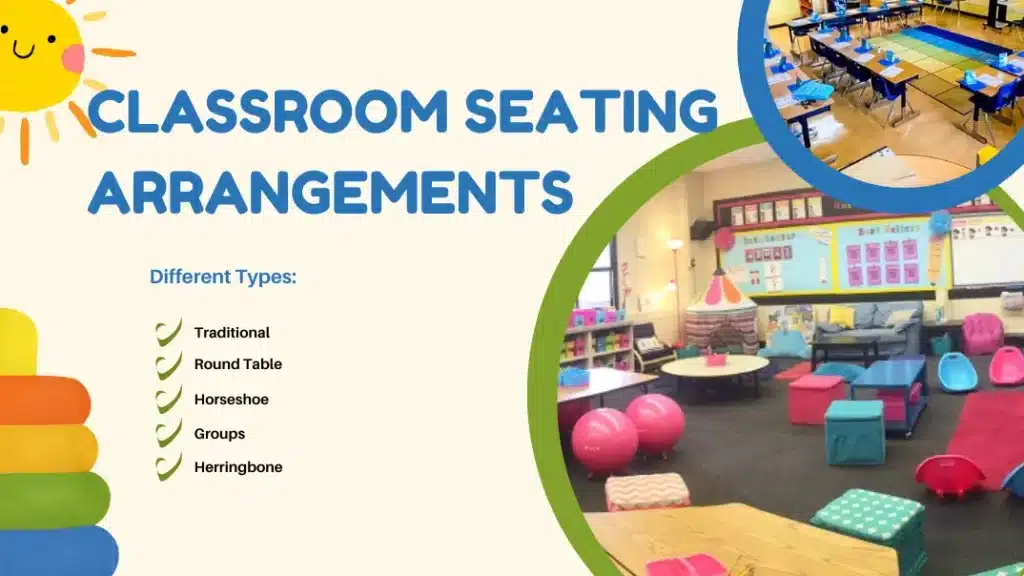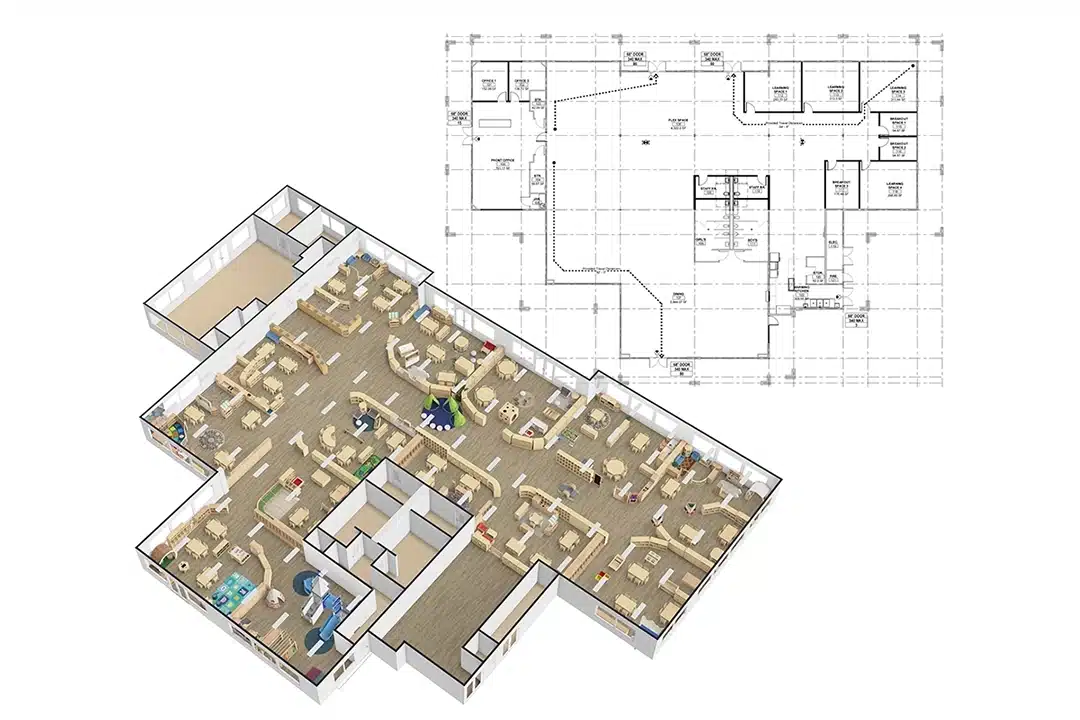Are you struggling to find the perfect classroom seating arrangement? Does your current layout encourage collaboration, focus, and engagement? Do you need a seating plan that adapts to different learning styles?
Classroom seating arrangements are far more than just a logistical necessity. How students are seated directly impacts their ability to focus, engage, and collaborate. A well-thought-out seating arrangement fosters a conducive learning environment, enhances student interaction, and aids classroom management. It’s not just about making the room look neat; the seating arrangement affects everything from student engagement to teacher-student communication.
Classroom seating arrangements are often one of the most overlooked elements in education. However, how we arrange seating can influence student behavior, interaction, and overall learning success.
What Is Classroom Seating Arrangement?
Classroom seating arrangement refers to how desks, chairs, or other seating elements are positioned to facilitate effective teaching, learning, and classroom management. This arrangement isn’t just about creating physical space and shaping social and academic interactions among students and between students and teachers. It can also influence focus, collaboration, and even behavior.
Seating arrangements in the classroom can be a game-changer for fostering student engagement. Students can be encouraged to work together in groups or become more isolated depending on how the desks are arranged. Good classroom seating arrangements must balance student interaction with the teacher’s need to control the class.

Importance of Classroom Seating Arrangements
Classroom seating arrangements are more than just about physical space—they shape learning dynamics. The right seating plan helps promote collaboration, enhances focus, and encourages positive behavior. A good seating arrangement fosters an environment where students can thrive.
Proper seating can increase participation, improve classroom management, and reduce distractions. Seating arrangements in the classroom have profound effects, affecting how students engage with the content and with each other. The choice of seating can also help create a space that suits different seating arrangements in the classroom for various activities and objectives.

Benefits of Flexible Seating in the Classroom
Flexible seating is a modern approach to classroom seating arrangements, where students can choose from various seating options like bean bags, stools, or standing desks. This flexible seating arrangement in classrooms has many benefits:
- Enhanced Engagement: Students are more likely to stay engaged when they can select a seating arrangement that fits their learning style. A flexible seating classroom arrangement allows them to choose what helps them focus best.
- Increased Collaboration: Students can quickly shift between group work and individual focus, making it perfect for classroom group seating arrangements.
- Promotes Comfort: Comfort leads to better focus, and when students can pick their seats, it reduces discomfort, which is crucial for maintaining attention.
- Student Autonomy: Allowing students to choose their seating empowers them and encourages a sense of responsibility for their learning environment.
Different Types of Classroom Seating Arrangements
Classroom seating arrangements for different purposes can range from traditional to more creative classroom seating arrangements. Depending on the activity, teacher’s goals, and student preferences, you may choose different seating setups. Let’s explore several types of seating arrangements, their advantages, and potential drawbacks.

1. Traditional Seating
In a traditional seating arrangement, desks are arranged in straight rows, typically all facing the front of the classroom. This setup is common in classrooms designed for lecture-based teaching, where students are expected to listen to the teacher, take notes, and engage in individual work.
Pros:
- Simple and Organized: Rows provide a clear structure for students and the teacher. In a traditional seating layout, it’sIt’s easy to monitor students.
- Efficient for Large Classes: This space-efficient setup allows many desks in a relatively small area.
- Focused Teacher-Student Interaction: The teacher can easily walk down the aisles and address individual students without distractions from other students.
Cons:
- Limited Collaboration: The rows encourage individual work rather than group collaboration. Students may find it challenging to engage in peer discussions or team activities.
- Inflexible: This setup doesn’t allow for much flexibility, and students who need more space or movement may feel confined.
- Passive Learning: This arrangement can foster a more passive learning environment where students receive information from the teacher without much interaction.

2. Round Table Seating
Round table seating arranges desks in a circular or oval shape, with the teacher usually at the center of the circle. This setup works well for discussions and activities requiring every student’s active participation.
Pros:
- Encourages Equal Participation: All students can see and engage with one another, making it easier for everyone to participate in discussions.
- Fosters a Collaborative Atmosphere: The circular arrangement encourages teamwork and collaborative learning.
- Improved Communication: Because everyone faces each other, communication flows more freely, allowing for more in-depth conversations and ideas exchanges.
Cons:
- Requires More Space: To accommodate a round table setup, the classroom must have sufficient space to arrange the desks in a circle or oval shape. This may not be possible in smaller classrooms.
- Less Efficient for Large Classes: A round table setup can be difficult to manage in larger classrooms. It is better suited to small groups or seminars.
- Distractions: With so much direct interaction, some students may become distracted or overwhelmed by the constant communication in this setup.

3. Horseshoe Seating
In the horseshoe seating arrangement, desks are arranged in a U-shape with the teacher at the open end. This layout works well for interactive lessons and allows the teacher to engage with every student easily.
Pros:
- Ideal for Discussion-Based Learning: The horseshoe shape encourages group discussions and enables the teacher to interact with all students.
- Clear Visibility: Students have a clear line of sight to the teacher and their peers, facilitating better communication and engagement.
- Effective for Small Groups: The horseshoe setup is ideal for smaller groups where interaction and participation are key.
Cons:
- Requires a Larger Classroom: To accommodate the U-shape, the classroom must be large enough to arrange desks without making the space feel cramped.
- Can Isolate Students: The open side of the horseshoe might leave some students feeling isolated or less engaged in the lesson.

4. Double Horseshoe Seating
The double horseshoe seating arrangement expands on the single horseshoe by creating two U-shaped formations. This setup can accommodate more students and is ideal for larger groups that require interaction.
Pros:
- Increased Student Interaction: With two horseshoe formations, more students can engage in discussions while maintaining proximity to the teacher.
- Clear Visibility for All: Students in both horseshoe formations can easily see the teacher and participate in the lesson.
- Encourages Collaboration: This setup is ideal for team-based activities or discussions involving multiple groups.
Cons:
- Space Constraints: Like the single horseshoe, the double horseshoe requires ample space to be effective. It may not be practical for smaller classrooms.
- Distractions: With more students in the room, keeping everyone focused on the lesson may become challenging.

5. Pods (Groups, Pairs)
In pod seating, desks are grouped in four, six, or more clusters, encouraging students to work together on projects or assignments. This is often used in classrooms that prioritize collaborative learning.
Pros:
- Encourages Teamwork: Pod seating promotes peer learning and teamwork. Students collaborate on tasks and learn from one another.
- More Personalized Learning: Smaller groups allow students to interact more directly with their peers and teachers.
- Flexible: Pods can be easily rearranged for various group sizes or activities.
Cons:
- Management Challenges: With students sitting close together, it can be difficult for teachers to maintain focus and avoid distractions.
- Limited Space: Pods may require a large room to accommodate multiple groups of desks. In smaller classrooms, it can be challenging to create effective pods.

6. Semicircle Seating
In a semicircle seating arrangement, desks are arranged in a half-circle, with the teacher at the center. This setup is ideal for group discussions, class participation, and interactive lessons.
Pros:
- Fosters Collaboration: Like round table seating, the semicircle encourages student interaction and collaboration.
- Improved Focus on the Teacher: The semicircle allows all students to face the teacher, making it easier for the teacher to engage everyone in the discussion.
- Great for Small Classes: The setup works best in small to medium-sized classrooms where the teacher wants to facilitate direct interaction.
Cons:
- Space Requirements: The semicircle requires adequate space for students to sit comfortably. It may not be feasible in tiny classrooms.
- Limited to Smaller Groups: This arrangement is not the best for large classes, and it can become challenging to manage effectively.

7. Square Seating
The desks are placed in a square formation, where students are facing one another. This arrangement encourages close interaction and is suitable for smaller, collaborative groups.
Pros:
- Face-to-Face Interaction: The square seating allows students to face one another, making it easier to collaborate and communicate.
- Great for Pair Work: This setup is perfect for pair or small group work where close collaboration is needed.
- Promotes Engagement: Students are likelier to engage when they are near one another and can communicate freely.
Cons:
- Limited Flexibility: The square arrangement may not be as flexible as others regarding shifting between activities or group sizes.
- Distractions: Students may become distracted by their peers’ proximity, reducing their focus on the lesson.

8. Face-to-Face Pairs
In this setup, students are seated in pairs, facing one another. This configuration works well for collaborative work, pair exercises, and individual student-teacher interactions.
Pros:
- Collaboration and Engagement: Promotes communication between students and allows for partner work.
- Suitable for Teacher Monitoring: Teachers can quickly check in with each pair of students.
Cons:
- Limited Interaction: Students may focus too much on their partner and not engage with the rest of the class.
- Distractions: Pairs may become distracted if they are not fully engaged with the task.

9. Herringbone Classroom Seating Arrangements
Desks are arranged at angles that face toward the front of the classroom, resembling the spine of a fish. This arrangement can create a unique atmosphere for focused instruction.
Pros:
- Focus on Front: The setup ensures all students face forward, which is ideal for lectures or presentations.
- Clear Sightlines: Every student has a good view of the board, projector, or teacher.
Cons:
- Limited Group Work: This arrangement discourages collaboration, as students are not sitting beside one another.
- Rigid Layout: It can feel too formal and less conducive to interaction or creative activities.

Things to Consider When Choosing Classroom Seating Arrangements
Several factors should be considered when selecting the right seating arrangement in the classroom to ensure that it suits the learning objectives, classroom size, and student needs.
Aligning Arrangements with Activities
Ensure that the seating arrangement aligns with the activities you plan to do. For example, pod or cluster seating might work best if you’re planning group projects. Traditional seating arrangements may be more effective if you’re delivering a lecture.
Classroom Size and Layout
The size and layout of the classroom are essential factors when deciding on a seating arrangement. Smaller classrooms may not have enough space for flexible seating options, and certain layouts, like the U-shaped seating arrangement classroom, may not be practical.
Student Height and Comfort
It’s important to ensure that students are comfortable during long periods of sitting. Consider classroom seating arrangements with desks that accommodate different heights and allow for proper posture.
Teaching Style
The arrangement should align with the teacher’s method. If your teaching is more lecture-based, rows may be the most effective. Consider group arrangements like pods or round tables for a more student-centered approach.
Comfort
Student comfort should be prioritized for optimal engagement. Ensure that desks and chairs are adjustable and enough space for students to move comfortably. Flexible seating can offer students more comfort and freedom of choice.

Tips for Maintaining an Effective Classroom Seating Arrangement
Once you’ve chosen a seating arrangement, it’s essential to maintain it for maximum effectiveness. Here are some helpful tips:
- Regularly Rotate Seating: Change seating arrangements to encourage fresh perspectives and minimize distractions.
- Ensure Flexibility: Allow students to move around occasionally, especially when restless or disengaged.
- Observe Student Behavior: Keep an eye on how students interact with one another and whether the seating arrangement works for everyone.
- Adapt for Special Needs: Ensure the arrangement accommodates students with physical disabilities or other special requirements.
- Create a Balanced Environment: Distribute students in a way that encourages positive interactions. For instance, talkative students should be near quiet ones to balance class dynamics.
Traditional vs. Modern Seating Arrangements
| Aspect | Traditional Seating | Modern Seating |
|---|---|---|
| Focus | Teacher-centered | Student-centered |
| Collaboration | Limited | Enhanced |
| Flexibility | Rigid | Flexible |
| Space Efficiency | Efficient in small rooms | May require more space |
| Ideal for | Lectures | Group work, discussions |
| Management | Easier to manage | More challenging |
| Student Comfort | Less flexible | High comfort |
How Does Seating Affect Learning?
Seating arrangements directly impact student learning, collaboration, and engagement. Students’ physical positioning in the classroom can either promote or hinder their focus, participation, and comfort. Classroom seating arrangements can significantly influence how students interact with one another, how easily they can engage with the teacher, and how effectively they absorb the material.
The right seating arrangement boosts student engagement and promotes a more inclusive classroom environment. When strategically placed, students can collaborate more efficiently, communicate with peers easily, and focus better on lessons. In contrast, poor seating arrangements may cause distractions, reduce collaboration, and hinder learning.

Strategies for Creating Inclusive Classroom Seating Arrangements
Creating an inclusive classroom environment ensures that every student feels welcome, comfortable, and supported. This is where an intentional classroom seating arrangement for different purposes plays a significant role. Teachers can create an atmosphere where all students feel included by choosing seating configurations that cater to various learning needs.
Inclusive Seating Strategies:
- Mix Different Learning Styles: Some students learn best in collaborative settings, while others might excel in more quiet, independent environments. Group and individual seating arrangements within the same space can address these differences.
- Adapt for Special Needs: Students with physical disabilities may require specific seating accommodations, such as ergonomic chairs or proximity to the teacher for easier interaction. A classroom seating arrangement for different purposes can accommodate these needs while fostering inclusivity.
- Promote Student Autonomy: Allowing students to choose their seats within specific parameters helps create a sense of responsibility and agency over their learning environment. This is especially effective in flexible seating arrangements in classrooms.
Using Seating to Solve Classroom Management Issues
Classroom management often depends on creating an environment where students can focus and engage with minimal disruption. Effective seating arrangements can be a powerful tool in improving classroom behavior and ensuring that lessons flow smoothly.
Tip 1: Create a Clear View of the Classroom
Classroom seating should allow the teacher to monitor the entire room easily. In a traditional setup, students might hide behind their peers, making it hard for the teacher to address behavioral issues. A horseshoe or semicircular arrangement provides a clear line of sight, allowing the teacher to maintain control of the room and intervene when necessary.
Tip 2: Separate Students with Behavioral Issues
If students are disruptive, consider separating them or placing them in areas where they’re less likely to distract others. Pairing them with a focused student might also help reduce distractions. While these placements should be handled delicately to avoid singling out students, strategic seating can promote a more positive environment.
Tip 3: Use Grouping to Prevent Isolation
Students who often isolate themselves or struggle to interact with peers may benefit from being seated in collaborative settings. Group work can help develop social skills, reduce loneliness, and improve peer relationships. Choose seating arrangements that encourage positive group dynamics and ensure that every student has an opportunity to engage with others.
Tip 4: Create Zones for Different Activities
Classroom zoning can be effective for managing behavior. For example, a quiet zone with individual desks for reading or writing can help students who are prone to distractions. A collaborative zone, with tables or grouped desks, can encourage teamwork. Establishing these zones allows students to focus on different activities and work without disruption.

Addressing Seating Arrangement Challenges
While seating arrangements can offer many benefits, they also have specific challenges that must be addressed for optimal effectiveness. Teachers can create a more harmonious and productive classroom environment by understanding these challenges and developing strategies to address them.
Common Seating Arrangement Challenges:
- Space Constraints: In smaller classrooms, fitting in enough seats while ensuring proper spacing can be challenging. To overcome this, consider cluster seating arrangements in classrooms or classroom seating arrangements with desks that allow individual work and collaboration.
- Balancing Group Work and Individual Focus: Finding the balance between collaborative seating arrangements and quiet, independent learning can be tricky. A flexible seating arrangement that allows students to move between different settings may solve this issue.
- Managing Large Classes: Maintaining a productive seating arrangement can be challenging with large groups. It might be necessary to experiment with different seating arrangements in the classroom to find the most effective setup for classroom seating arrangements for 30 students.
FAQs
- How can seating arrangements affect student behavior?
The right seating arrangement allows the teacher to monitor students easily, positioning disruptive students closer to the teacher to encourage focus and engagement. - What’s the best seating arrangement for a small classroom?
Cluster seating arrangements in classrooms can help maximize space while promoting interaction and collaboration. - Can flexible seating arrangements improve classroom participation?
Yes, flexible seating arrangements give students the freedom to choose seats based on their learning preferences, leading to better engagement and participation. - What is the best seating arrangement for managing a talkative class?
Traditional seating arrangements in rows or U-shaped seating arrangements allow for better monitoring of students and help reduce distractions. - What challenges do teachers face when choosing a seating arrangement?
Teachers often struggle with space constraints and balancing the need for group work with individual focus. Flexible seating arrangements can help address these challenges. - What’s the best seating arrangement for a talkative class?
Circle seating arrangements or U-shaped seating can help manage talkative students by making the teacher a more central part of the class. - How does a semicircle seating arrangement work?
The semicircle seating arrangement places students in a half-circle facing each other, which facilitates interaction and engagement with the teacher. - Is a traditional row seating arrangement still effective?
While it’s not as interactive, row seating can still be effective for lecture-based instruction and large classes where the teacher needs to maintain control.
Conclusion
Classroom seating arrangements are powerful tools for enhancing the learning environment. By carefully selecting and customizing your seating plan, you can improve student engagement, collaboration, and overall classroom management. The key is aligning the seating arrangement with your teaching style, class size, and educational goals. Whether you opt for traditional rows, flexible seating, or any other configurations discussed, an intentional seating arrangement can foster a more productive and enjoyable learning experience for your students.

















